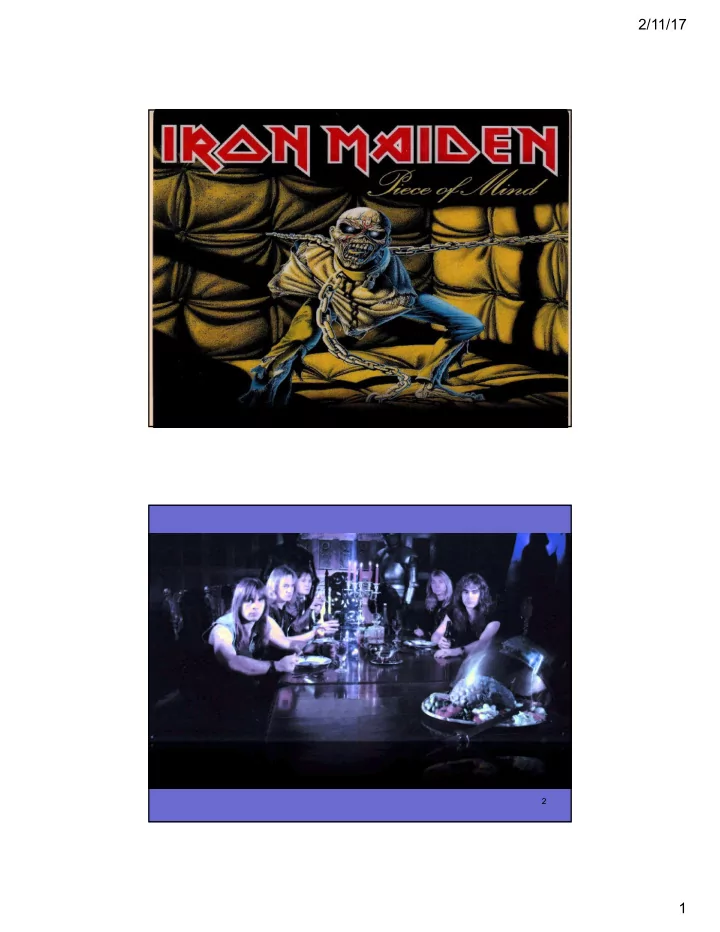

2/11/17 1 2 1
2/11/17 Visual System II: objects and faces I. Local vs. distributed functions II. Interlude—four kinds of experiments III. Ventral and dorsal streams and the sensory hierarchy IV. Face cells—early electrophysiology V. fMRI and face areas VI. Recent single unit recordings— hierarchy again 3 Phrenology 2
2/11/17 Jean Pierre Flourens 1794-1867 “Equipotential” cortex Hippocrates “Men ought to know that from the brain and from the brain only arise our pleasures, joys, laughter, and jests as well as our sorrows, pains, griefs and tears.“ 4 th century B.C. 3
2/11/17 Visual System II: objects and faces I. Local vs. distributed functions II. Interlude—four kinds of experiments III. Ventral and dorsal streams and the sensory hierarchy IV. Face cells—early electrophysiology V. fMRI and face areas VI. Recent single unit recordings— hierarchy again 7 Interlude: 4 kinds of experiments • Block • Measure • Mimic • Determine 4
2/11/17 Why do we think the brain is the organ most directly related to behavior and mind? Hypothesis: the brain controls behavior Brain lesions: block 5
2/11/17 Functional Magnetic Resonance Imaging Measure Intracranial microstimulation Wilder Penfield (1891-1976) Mimic 6
2/11/17 A victory for the localizationist, modular point of view 1947 Joachim Bodamer reports on three cases of “prosopagnosia”: specific loss of face recognition ability à Suggests? 7
2/11/17 Swiss-Army Brain? or general purpose computer? 15 Visual System II: objects and faces I. Local vs. distributed functions II. Interlude—four kinds of experiments III. Ventral and dorsal streams and the sensory hierarchy IV. Face cells—early electrophysiology V. fMRI and face areas VI. Recent single unit recordings— hierarchy again 16 8
2/11/17 Sensory system motifs • Topography • Parallel processing • Hierarchy 17 Topographic organization: Neighboring regions of sensory surface project to neighboring brain regions. 18 9
2/11/17 19 Parallel processing Relatively independent neural pathways or modules process different sensory features at the same time (...which must somehow be combined to form a coherent behavioral response or unified perception: The Binding Problem.) 20 10
2/11/17 Extrastriate visual cortex 1) Ventral Stream projects to inferior temporal cortex Color -- Achromatopsia Faces -- Prosopagnosia “What” -- conscious perception of objects 2) Dorsal Stream projects to posterior parietal cortex “Where” & “How” -- manipulating objects 21 Face area 22 11
2/11/17 Sensory Hierarchy Ascending through stages into the brain, neurons represent progressively more complex sensory features 23 Hierarchical organization: • Peripheral ( lower ) levels of the sensory hierarchy respond to simple features and have relatively small receptive fields • Central ( higher ) levels respond to more complex stimuli and have larger receptive fields 24 12
2/11/17 Visual Hierarchy 25 13
2/11/17 Ventral visual pathway Progressing to higher areas along the ventral pathway: response latency increases receptive field size increases neurons become selective to more complex spatial patterns neural responses become more invariant to changes in position, scale, pose, etc. Object boundaries in V2 and V4 Some V2 neurons respond to illusory contours Zhou, Friedman & von der Heydt (2000) Others found selectivity for the orientation of stereo and motion • Border ownership distinction arises boundaries in areas V2 and V4 only ~ 25 ms after edge response • Response is scale invariant Qiu & von der Heydt (2005) Similar border ownership distinction for stereo edges right left time 2 time 1 14
2/11/17 V2 and V4 responses to complex shapes Hegde & Van Essen, 2007 Visual System II: objects and faces I. Local vs. distributed functions II. Interlude—four kinds of experiments III. Ventral and dorsal streams and the sensory hierarchy IV. Face cells—early electrophysiology V. fMRI and face areas VI. Recent single unit recordings— hierarchy again 30 15
2/11/17 Face selective cells in IT cortex Locations of face selective cells in IT, from single cell recordings Desimone et al., 1984 i.e. DISTRIBUTED 16
2/11/17 Visual System II: objects and faces I. Local vs. distributed functions II. Interlude—four kinds of experiments III. Ventral and dorsal streams and the sensory hierarchy IV. Face cells—early electrophysiology V. fMRI and face areas VI. Recent single unit recordings— hierarchy again 33 MRI vs. fMRI functional Magnetic Resonance Imaging (fMRI) low spatial resolution (~1 mm) many images (~ every 2 sec for 5 mins) best spatial resolution available for measuring neural activity noninvasively ... in the whole human brain increased neural activity à increased local blood flow à change in oxygenation of hemoglobin à increase in MRI signal Blood Oxygenation Level Dependent (BOLD) signal is an indirect measure of neural activity raw data: ~30,000 3D “voxels” (each voxel: hundreds of thousands of neurons) 17
2/11/17 fMRI experiment Functional images ~2s Time ~ 5 min 36 18
2/11/17 Fusiform Face Area (FFA) in the human brain Visual System II: objects and faces I. Local vs. distributed functions II. Interlude—four kinds of experiments III. Ventral and dorsal streams and the sensory hierarchy IV. Face cells—early electrophysiology V. fMRI and face areas VI. Recent single unit recordings— hierarchy again 38 19
2/11/17 Face patches in macaque IT cortex Tsao, Freiwald, Tootell, Livingstone, 2006 Targeting neurons in middle face patch using single cell recording Tsao et al. 2006 20
2/11/17 Responses become more invariant to pose of face while becoming more specialized for particular identity 41 Single neuron action potential recording from human temporal lobe! Quiroga et al., 2005 42 Quiroga et al ., 2005 21
2/11/17 Swiss-Army Brain? or general purpose computer? 44 22
2/11/17 ( Nature Neuroscience , 2000) 45 Conclusions • Visual neurons are arranged in retinotopic “maps” • The cortex is organized hierarchically : More complex and specific feature-sensitivities are constructed from lower-level features • The cortex has parallel localized “modules” specialized for different functions, features, and objects, like speech, faces , color, motion…even “theory of mind” 46 23
Recommend
More recommend